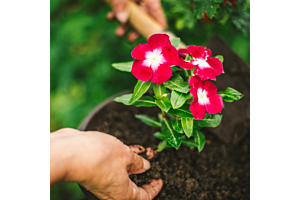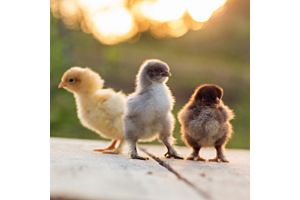Tips for Successful Canning

Tips for Successful Canning with 60+ Years of Experience
By Katie Bigley
Canning can be a very rewarding hobby as there is nothing like the feeling of stocking your cabinets with homegrown food or gifting your friends your secret recipe salsa made with tomatoes from your backyard. But, for someone with no experience who wants to begin canning on their own, it may seem time-consuming and daunting. Ginger, a cashier at Quincy Farm & Home Supply has years of canning experience and shares some information on how to get started. It’s not as complicated as you might think!
Meet Ginger – Farm & Home Supply’s very own “expert canner”. She has been with the Quincy team for almost eight years. What makes Ginger the go-to person for canning needs? Just her casual 60+ years of experience!
When I asked Ginger how she got into canning, she shared that her grandmother began to teach her about canning when she was about 5 or 6 years old with an old pressure cooker. When she was younger, Ginger recalls that her grandmother would have her sit and watch the steam opening on the canner to determine when the canned goods were done. As she got older, she would have more hands-on work in the kitchen helping her grandmother out.
Ginger still has the old pressure cooker she grew up using with her grandmother and she was able to bring it in for me to see. While looking at the old pressure cooker, I kept thinking to myself “Thank goodness for advancements in technology!” This old pressure canner must be pushing 200 years old, lacking any pressure gauges, and the only thing keeping the lid on is four clamps spaced evenly apart! Ginger described the pressure cooker as “hardly safe.” I can’t say that I disagree with her statement. But hey, it did the job, and it still looks to be in great condition with a lot of life left in it. Thankfully though, Ginger and her grandmother were able to get a more modern pressure canner with all the bells and whistles and, most importantly, safety features. Now, the vintage pressure cooker is a keepsake that holds fond memories of Ginger’s childhood in the kitchen with her grandmother.
Now, let’s get into the canning information. We will touch on the supplies needed, different methods, common questions you may run into, and some helpful tips. I don’t do any canning myself. However, it is something I would like to get into eventually. Like most people who are in my position, I’m sure we share the same question – where do I even start?
Supplies needed - Ginger shares with us that Farm & Home carries a 5-piece canning tool set with all the basic utensils you need to get started: a funnel, spatula, measuring spoon, jar clamps, and jar tongs. Pretty easy, right? In addition to those basic supplies, you will also need mason jars, jar lids, and seals. Finally, you will have to determine what method of canning you decide to do: water bath or pressure canning. If you choose to do the water bath method, you will just need a large stock pot. If you decide to do pressure canning, you will need a specialized pressure cooker.
Wait, there are different methods of canning. Yes, there are two methods of canning and Ginger breaks down the differences between the two methods for us:
Water-Bath Canning: A method of preserving food by placing sealed jars in a pot of boiling water for a set amount of time. This process is used for high-acid foods.
Pressure Canning: A method of preserving food by using a specialized pressure pot that is designed to reach high temperatures to kill harmful bacteria. This process is used for low-acid foods.
How do I determine what method to use? That comes down to what types of food you decide to eat. There are low-acid foods which are mostly vegetables, meat, pork, and poultry. Then, there are high-acid foods like fruit (jams/jellies) pickles, and tomatoes (salsa/pasta sauce).
Now, let’s get into some common questions you may run into along the way.
Common Canning Question #1:
Why didn’t my jars seal?
The first step when faced with this issue is to check your jars before you begin filling them. Run your finger around the edge of the opening to make sure there are no chips or malfunctions at the top of the jar which may hamper the sealing process. Another preventative measure is to wipe the mouth of the jar off after you’ve filled it. Ensuring the mouth of the jar is clean, not sticky, and free of anything that may interfere with the sealing. Also, make sure you aren’t filling your jars too full as this will cause them to not seal properly. Ginger says to leave about a ½ inch of space at the top of the jar to be safe. Finally, be sure not to tighten the lids too tight because this could cause the lids to buckle and affect the sealing process as well.
Common Canning Question #2:
Can I reuse canning lids?
No, you are not able to reuse canning lids. Once a lid has been used, throw it away and grab a new lid for the new batch of canned goods. However, you may reuse the rings. Ginger says if you decide to reuse the rings to be aware of any rust that may form over time after repeated use and to throw the ring out if you see any signs of deterioration.
Common Canning Question #3:
How long can I store homemade canned goods?
Two years roughly, if the canned goods are kept in a cool, dry, dark space. Be sure to inspect stored canned goods for any sign of damage or spoilage like mold or bubbles before you serve them. Throw out any canned food that does not smell or look right.
We will wrap up this blog by sharing some tips from Ginger on jams/jellies, as those are some of the more common foods to can at home.
First, Ginger explains that it’s important to use real cane sugar when making jams and jellies because most of the time, the cheaper sugar is made with potatoes (I sure didn’t know that!) She says that using real cane sugar, helps the jams set better and have a clearer consistency.
How do I know when my jam/jelly is set? - There are two methods for determining if your jam is set. The first one is the drip test. With this test, Ginger says to take a spoon, dip it in the jam, and simply watch the drips. This will help you determine the consistency of your jam. If the drips fall off the spoon in separate, distinct drops - your jam is not set yet and needs to continue cooking. If the drips form a sheet on the spoon and slide off together – your jam has reached the gel point and is ready to be canned.
Then, there is also the saucer test if you don’t feel confident with the spoon test. The saucer test involves putting a saucer or small plate in the freezer for about 30 minutes. Take out the saucer and place a small amount of the jam on the saucer. If the jam spreads out quickly and runs around the saucer after a few minutes – it isn’t ready yet. If the jam starts to sheet up or wrinkle slightly – it has reached the gel point and is ready to be canned
Aside from the short list of supplies, canning is a simple hobby to get into once you find reliable recipes and reputable sources for instructions and information to guide you along the way.
Canning may seem overwhelming at first and it might take a few rounds of trial and error but with some good practice and the right recipes, it can be a very rewarding hobby that will leave you feeling accomplished. Who knows, maybe it could become a memorable family tradition for years to come by passing down knowledge and experience like Ginger had with her grandmother.
Thank you, Ginger, for being a part of this blog!










